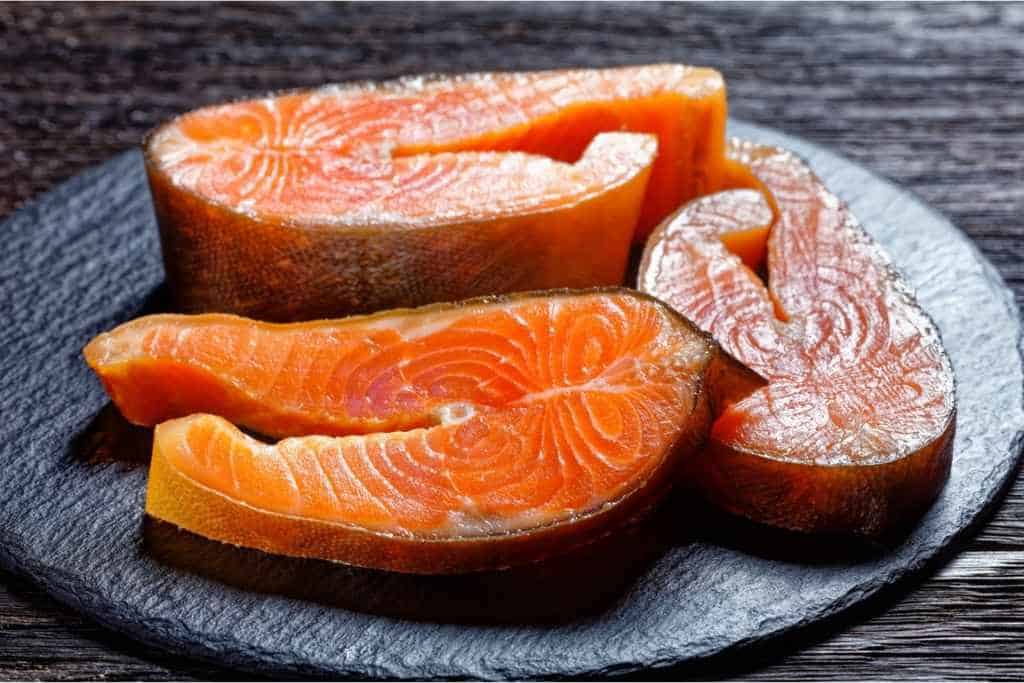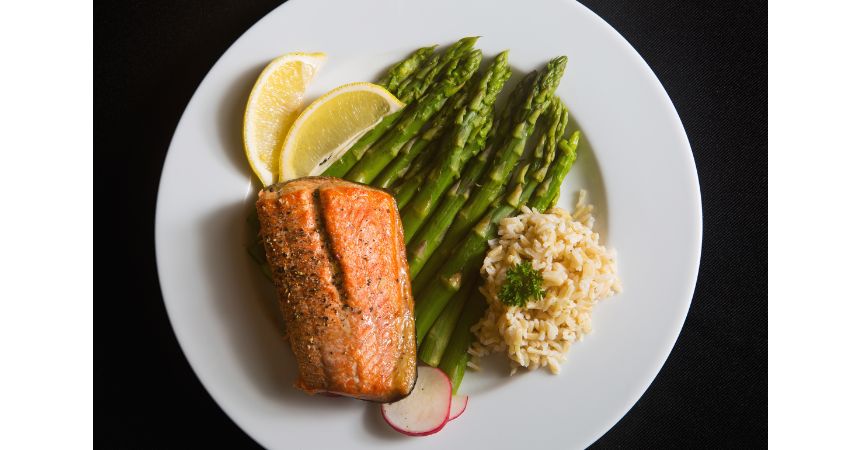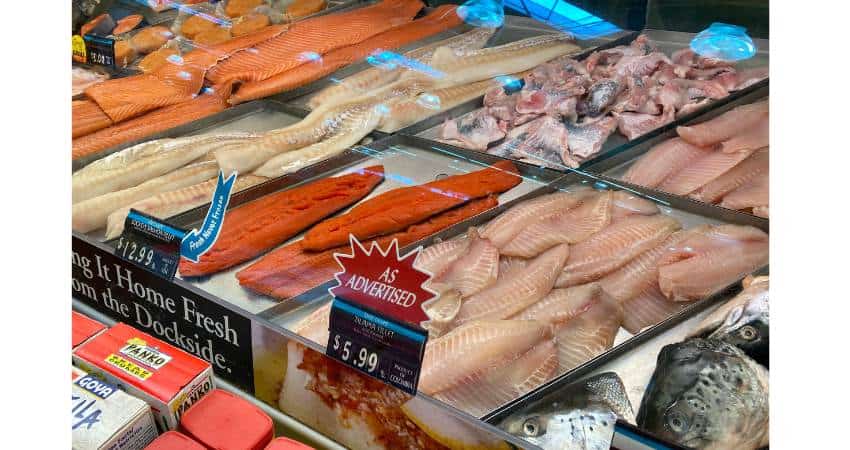Atlantic vs Pacific Salmon: The Differences
When deciding which salmon to choose, you’ll want to examine the difference between Atlantic salmon and Pacific salmon.
Atlantic Salmon has a slightly milder taste and firmer flesh than Pacific salmon. Atlantic Salmon live a little longer and is found in the North Atlantic Ocean while Pacific salmon is native to the North Pacific Ocean. Pacific salmon costs more than Atlantic.
This article will examine all the differences between the two fish in detail. I’ll compare their tastes, textures, costs, mercury levels and benefits. In addition, a table comparing their nutrients side-by-side is included.
Atlantic Salmon: The Basics
As a Certified Health Coach many clients ask me about comparing seafood including salmon. Also, I purchase and consume it every week. Therefore, I have researched this topic in the past and present. Let’s examine both types closely.

Yep, you guessed it, Atlantic salmon live in the Atlantic Ocean. However, despite being named after an ocean, Atlantic salmon are born in freshwater streams. They spawn and are born in the stream. When they grow old enough and large enough, they migrate to the ocean ((Oceana: Atlantic Salmon)).
Pacific Salmon: The Basics
Pacific and Atlantic salmon are actually from the same family, though they both have different genera. There are five species of pacific salmon:
- The chinook (or king)
- Coho
- Pink
- Chum
- Sockeye
All these salmon species are natives to the pacific ocean (for the sake of time and space, we will focus primarily on the king/chinook salmon). I do have the following articles comparing more Pacific salmon species against each other in complete detail:
Coho Salmon vs King: What’s The Difference?
Coho Salmon vs Sockeye: What’s The Difference?
Keta vs Sockeye Salmon: What’s The Difference?
Pink Salmon vs Sockeye: The Complete Comparison
Sockeye vs King Salmon: A Complete Comparison
The Differences: Taste and Texture![]()
The difference between the two fish as far as taste and texture are concerned is very minimal. Most would say only a very refined and sophisticated palate would be able to discern exactly what those differences are.
Atlantic salmon is said to be much milder tasting than Pacific salmon with firmer flesh. Pacific salmon tends to be a bit more tender with smaller flakes while Atlantic salmon has very large flakes.
As far as taste and quality are concerned, you will have to be the judge of which is better, if, indeed, you can detect any differences at all. As said, the difference in flavor is quite minimal and will therefore be difficult to discern.
MY Poll and Taste Test at Home
I wanted to conduct original research and get the opinion of real people like you. Therefore, I contacted my clients, readers and members of food groups I belong to. I asked them which of the two salmon they preferred.
- 52% said they preferred the taste of Pacific.
- 40% said they preferred the taste of Atlantic.
- 8% said they had no preference, or it depended on their mood.
I set up a blind test taste at home. Five people were given a cooked fillet of each salmon. Each one was cooked and seasoned the same way.
Three of the five, 60%, chose the Pacific over the Atlantic. Therefore, Pacific salmon was the winner in my poll and blind taste test.

Atlantic and Pacific Salmon: Substitutions
Your local grocery store may not always have the type of salmon you’re looking for. If you are looking for a substitution, let’s examine.
Atlantic salmon and Pacific salmon can substitute for each other in recipes, although they have slightly different textures and tastes. They both can be cooked using the same methods like pan-fried, slow-roasted, poached, baked or searing in a pan.
Atlantic and Pacific Salmon Nutrients
The following table compares the nutrients between Atlantic Salmon and various Pacific salmons.
| Nutrient | Atlantic Salmon, raw
(4 Ounces) |
King Salmon, raw
(4 Ounces) |
Coho Salmon, raw
(4 Ounces) |
Sockeye Salmon, raw
(4 Ounces) |
| Calories | 161 | 212 | 166 | 149 |
| Fat | 7.2 g | 13 g | 6.7 g | 5.3 g |
| Saturated Fat | 1.1 g | 2.1 g | 1.4 g | 0.9 g |
| Cholesterol | 62 mg | 69 mg | 51 g | 58 mg |
| Protein | 23 g | 23 g | 25 g | 25 g |
| Omega-3 | 1.95 g | 1.45 g | 1.49 g | 0.96 g |
| B-6 | 0.9 mg | 0.3 mg | 0.6 mg | 0.8 mg |
| B-12 | 3.6 mcg | 8.3 mcg | 4.7 mcg | 5.3 mcg |
| Thiamin | 0.20 mg | 0.18 mg | 0.12 mg | 0.15 mg |
| Riboflavin | 0.40 mg | 0.19 mg | 0.15 mg | 0.23 mg |
| B5 | 1.8 mg | 1.1 mg | 0.9 mg | 1.2 mg |
| Iron | 0.9 mg | 0.9 mg | 0.6 mg | 0.4 mg |
| Niacin | 8.9 mg | 9.5 mg | 8.1 mg | 9.6 mg |
| Folate | 28.3 mcg | 17.0 mcg | 10.2 mcg | 6.8 mcg |
| Potassium | 555 mg | 419 mg | 479 mg | 416 mg |
| Magnesium | 32 mg | 27 mg | 35 mg | 34 mg |
| Phosphorus | 226 mg | 235 mg | 297 mg | 291 mg |
| Calcium | 13.6 mg | 47.6 mg | 40.8 mg | 10.2 mg |
| Zinc | 0.7 mg | 0.5 mg | 0.4 mg | 0.5 mg |
| Selenium | 41.4 mcg | 35.2 mcg | 41.4 mcg | 33.8 mcg |
Nutritional value sources12 ((USDA: Fish, salmon, Atlantic, wild, raw)) ((Nutrition Value: Fish, raw, (Alaska Native), king (chinook), salmon))
Health Benefits
As far as health benefits are concerned, there are no major differences worth mentioning. The real question is not whether Pacific salmon is healthier than Atlantic salmon, but rather whether farmed or wild-caught salmon is healthier.
I wrote a whole article comparing the two. The food they consume is much different besides their environments. There is a huge difference which you can read about here, Farm Raised Salmon Compared To Wild Caught Salmon.
Regardless, however, there are plenty of health benefits that most kinds of salmon have to offer. Many health professionals would recommend including salmon (as well as other kinds of oily, fatty fish) in your diet.
First and foremost, salmon is very rich in both protein and omega-3 fatty acids. Protein, of course, is a very important part of one’s diet. Protein gives you strength and will keep your body functioning regularly.
Omega-3s are extremely good for your heart. It can help reduce blood pressure, inflammation, and significantly reduce the risk of heart disease and several other diseases like prostate cancer ((National Center for Biotechnology: Marine Omega-3 Supplementation and Cardiovascular Disease)).
Salmon is also packed with a plentiful bounty of B vitamins, including riboflavin, B12, niacin, thiamin, B6 and folate. In addition, there’s plenty of other vitamins and minerals helping to keep the blood in good health ((National Center for Biotechnology Information: Benefits of salmon eating on traditional and novel vascular risk factors in young, non-obese healthy subjects)).
If weight management has ever been a problem for you, salmon might be the wonder food you’ve been looking for. Because salmon is a good, clean source of protein, it has hormone regulating properties and acts as an appetite suppressant.
Heart health is not the only reason you should ingest omega-3s. Fish oil and fatty acids like the ones found in salmon have been proven to significantly improve and protect brain health. They are both good to take for depression and anxiety.
Atlantic or Pacific Salmon: Mercury Levels
The Food and Drug Administration and the Environmental Protection Agency have issued warnings regarding mercury levels3.
They established a list of fish that are best choices, good choices and ones to avoid.
Atlantic salmon and Pacific salmon have similar levels of mercury. All salmon are listed on the FDA’s best choices of fish to consume regarding their mercury levels.
Always check with a physician prior to eating new foods or changing your dietary habits.
Atlantic vs Pacific Salmon: Prices

When you are purchasing any kind of salmon, be sure to check the label to see if the fish is wild caught or farm-raised. This makes a difference with cost as wild is always more expensive. In addition, your area, store and whether the fish is frozen or fresh changes the price.
Pacific salmon is more expensive than Atlantic salmon. The average cost for fresh wild Pacific salmon is $20.61 per pound while the average cost for fresh wild Atlantic salmon is $14.99 per pound.
I checked FreshDirect and found the following prices:
- Fresh wild Atlantic fillet
- $14.99 per pound
- Fresh wild pink fillet
- $13.99 per pound
- Fresh wild sockeye fillet
- $18.50 per pound
- Fresh wild Coho fillet
- $19.99 per pound
- Farm King fillet
- $29.99 per pound
The Pacific’s King, Coho and sockeye are responsible for the higher cost. The Pacific pink is similar in cost to Atlantic Salmon.
If you have any questions to ask me about this article don’t hesitate to comment below or email us. You can find an email on our contact page.
Read Next – More Salmon vs Fish Articles!
Atlantic vs Wild Salmon: Which Is Better?
Pink vs Red Salmon: What’s The Difference?
Sardines vs Salmon: A Complete Comparison
Frozen Salmon vs. Canned Salmon: Which Is Healthier?
- Nutrition Value: Fish, raw, sockeye, salmon [↩]
- Nutrition Value:Nutrition Value: Fish, raw, wild, coho, salmon [↩]
- FDA: Advice about Eating Fish [↩]
